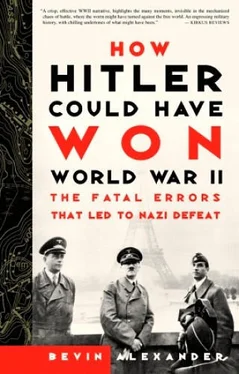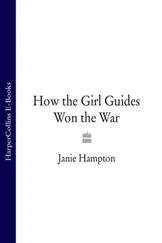A note on the Notes: Some references cite only the last name of the author or editor. These works are cited in full in the Selected Bibliography. References not so listed are cited in full where they appear. Numbers refer to pages.
Chapter 1: Germany’s Opportunity for Victory
p. 2: “after France fell.” Kimball, 48.
p. 2: “the European continent.” Ian Kersaw in Finney, 132.
p. 3: “Schutzstaffel or SS.” Dahms, 332–38.
p. 4: “or were murdered.” This book focuses on the military and political decisions open to Germany in World War II. Nothing in it should be misunderstood as approval for what the Third Reich did in six years of pillage and genocide, carried out by Nazi authorities and private soldiers alike. This book seeks to explore how close we came to losing the war, and how close Adolf Hitler came to creating the unspeakable world he wanted. There is insufficient space to examine the Holocaust and other murderous programs Hitler and Nazi Germany pursued to the very last days of the war. There are many fine books on this aspect of Nazism. Two of the best are Hitler’s Willing Executioners by Daniel Jonah Goldhagen, and an official German study of the Einsatzgruppen, or murder units, in eastern Europe from 1939 to 1942: Die Truppe des Weltanschauungskrieges (The Troops of the War of Ideology) by Helmut Krausnick and Hans-Heinrich Wilhelm. For human losses, see Zabecki, vol. 1, 32–34 (Paul J. Rose); Omer Bartov, Hitler’s Army, 83–84.
p. 6: “kinds of vehicles. ” Fuller, vol. 3, 379–81.
p. 7: “‘had time to react.’” Rommel, 124.
p. 7: “infantryman could walk.” France had about 3,400 modern tanks, though not all were in organized tank units. Britain sent about 700 tanks to the Continent, mostly Mark VI light tanks, with 14-millimeter armor and armed with two machine guns, the rest Matildas, a powerful, slow (maximum speed 15 mph, but operating even slower) “infantry” tank with 70-millimeter main armor. Most were the Mark I version armed only with a machine gun, and only 50 were Mark IIs with a high-velocity two-pounder (40-millimeter) gun. On May 10, 1940, 2,300 French tanks had been formed into 51 battalions: 12 in three armored divisions, 12 in three light mechanized divisions, 27 in independent battalions. Each French battalion usually had 45 medium or light tanks, or 33 heavy tanks. The French deployed mostly infantry tanks with thick armor (34–60 millimeters), short range, and slow speed. Most had a good 37-millimeter gun, and some had an excellent high-velocity 47-millimeter gun. Either could pierce most German armor. See Goutard, 27–28; Zabecki, vol. 2, 1107–10, 1131–32 (Kenneth J. Swanson, Robert G. Waite, and John Dunn); Ellis, 88–89.
p. 8: “speed of only 240 mph.” This was the 1938 model with a 490-mile range used in the 1940 campaign. In 1941 the Ju-87D came out with a 4,000-pound pay-load and a 950-mile range. The D-model saw heavy and successful service in North Africa and Russia.
p. 8: “on the battlefield.” The German Wehrmacht (armed forces) were the first to develop close tactical or battle cooperation between aircraft and ground troops. A Stuka could drop a bomb within a hundred yards of any target designated by the ground forces. The Luftwaffe sent liaison officers to corps and panzer divisions to relay requests for support. In the campaign in the west, panzer forces could receive air support forty-five to seventy-five minutes after the request was made. See Corum, 271–75.
Chapter 2: The Campaign in the West: 1940
p. 9: “east of Holland.” Dahms, 162; Das Deutsche Reich und der Zweite Weltkrieg, vol. 2, 238–47 (Hans Umbreit).
p. 11: “the French army.” Manstein, 100–102; Cooper, 198–200.
p. 11: “‘was inadmissible,’ Manstein wrote.” Manstein, 103–104.
p. 12: “‘of the German offensive.’” Ibid., 118.
p. 13: “‘had to say,’ Manstein wrote later.” Ibid., 121.
p. 15: “vulnerable to ground fire.” Goutard, 32–37.
p. 16: “on only slightly inferior terms.” Zabecki, vol. 2, 962, 964–66, 983–85 (Carl O. Schuster, Philip C. Bechtel).
p. 16: “could be moved forward.” Kiesling, 140–42.
Chapter 3: The Defeat of France
p. 20: “Walther von Reichenau’s following 6th Army.” Zabecki, vol. 2, 1471–72 (Kevin Dougherty); Das Deutsche Reich und der Zweite Weltkrieg, vol. 2, 285–87 (Hans Umbreit); Dahms, 166–69; English and Gudmundsson, 61.
p. 21: “to Antwerp, Belgium.” The Allied land forces were divided into the 1st Group of Armies (Billotte), located between the English Channel and Montmédy, and including 7th Army (Giraud), the BEF (Gort), 1st Army (Georges Blanchard), 9th Army (André Corap), and 2nd Army (Charles Huntziger); the 2nd Group of Armies (Gaston Prételat) between Montmédy and Sélestat (thirty miles south of Strasbourg on the Rhine River), and including 3rd Army (Charles Condé), 4th Army (Edouard Réquin) and 5th Army (Victor Bourret); and the 3rd Group of Armies (Georges Besson) between Sélestat and Geneva, Switzerland, with 8th Army ( Joanny J.M. Garchery) and 3rd Army (Robert Auguste Touchon).
p. 22: “to the German panzers.” Goutard, 111–13.
p. 22: “‘Victory whatever the cost!’” Churchill, The Second World War, Their Finest Hour, 25–26.
p. 23: “in their thrust westward.” Guderian’s three divisions had 276 tanks each, Reinhardt’s two divisions 218 each; Hoth’s 5th Division had 324 tanks, his 7th Division 218; Hoepner’s two divisions had 324 tanks apiece, and the 9th Division (detailed to Holland) 229: total 2,683. Of these, 640 were Mark Is, 825 Mark IIs, 564 Mark IIIs, and 654 Mark IVs. The Mark Is were inadequate for combat and were relegated to reconnaissance. They weighed 6.5 tons, were armed with two machine guns, and had maximum armor 15 millimeters thick. The Mark IIs also were inadequate, weighed 10.5 tons, had only a 20-millimeter gun and 30-millimeter armor. The Mark IIIs carried a 37-millimeter gun and had 57-millimeter maximum armor. The Mark IVs mounted a short-barreled 75-millimeter gun and had maximum of 60-millimeter armor. All four models could travel at about 25 miles per hour. However, the tanks designated Mark IVs in the 6th, 7th, and 8th Panzer Divisions were Czech Skodas. They weighed 11.5 tons, could travel 21 miles an hour, had 25-millimeter maximum armor, and carried a 37-millimeter gun. See Goutard, 27; Chapman, 347; Zabecki, vol. 2, 1111–14, 1133 (Paul W. Johnson and Robert G. Waite).
p. 23: “‘think there is any danger?’” Chapman, 113.
p. 25: “‘guns had been abandoned.’” Ibid., 121.
p. 28: “‘boundless shores’ ( Uferlose ) .” Dahms, 171.
p. 28: “and seized Bouvellement.” Guderian, 108.
p. 31: “attempted no further attack.” Ellis, 90–98.
p. 32: “‘and protective movements.’” Liddell Hart, The German Generals Talk, 132.
pp. 33–34: “‘the liberation of the Old.’” Churchill, The Second World War, Their Finest Hour, 118.
p. 35: “51st Highland Division.” Rommel, 44–67.
p. 35: “‘the back of its neighbor.’” Kimball, 51.
Chapter 4: Hitler’s First Great Error
pp. 36–37: “‘their finest hour.’” Churchill, The Second World War, Their Finest Hour, 225–26.
p. 38: “pick up low-flying aircraft.” One of the greatest British feats in the war was breaking the German Enigma cipher machine’s code by the Government Code and Cipher School at Bletchley, between Oxford and Cambridge. Radio intercepts of Enigma-encoded messages gave the Allies advance warning of many German actions, plans, and dispositions. A Berlin commercial company invented the Enigma machine, and the army adopted it in the late 1920s and other governmental agencies in 1933. The machine mechanically enciphered plain text messages by means of three cipher drums, or rotors, with twenty-six letters along the rims and a fourth stationary reflector or reversing cipher drum. Changing the connections of these four rotors gave almost infinite potential codes. The Germans regarded Enigma transmissions as unbreakable. Polish intelligence turned over one of these machines to the British in late July 1939. Mathematicians at Bletchley began a laborious process of breaking the codes based on the repeated sequence of letters an operator was obliged to preface messages with to show the receiving station how he had geared or set the machine. Luftwaffe keys were the first broken, but Gestapo keys were never broken. The Bletchley operation was code-named Ultra. Its first great victory was in the Battle of Britain, when Ultra was able to give key advance information on Luftwaffe operations to the RAF. See Zabecki, vol. 2, 959–60, 1290–91 (Alexander Molnar, Jr.); Keegan, Second World War, 163–64, 497–502; Ronald Lewin, Ultra Goes to War: The Secret Story, London: 1978.
Читать дальше


![Джонатан Димблби - Barbarossa - How Hitler Lost the War [calibre]](/books/385421/dzhonatan-dimblbi-barbarossa-how-hitler-lost-the-w-thumb.webp)









